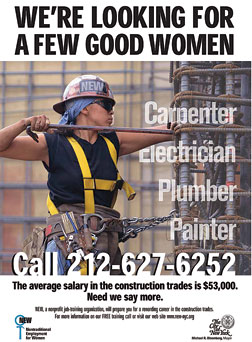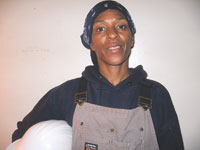 |
Femi Agana came to New York City in 1983 to pursue a career as a fashion designer. Inspired by her three children, she opened a children’s clothing boutique in Brooklyn. Then reality set in. Agana fell into debt, and suddenly found herself unemployed. Walking into an unemployment office, she noticed an ad for Nontraditional Employment for Women (NEW), a locally based non-profit group looking to attract and train women for careers in union construction trades. Seven years later, Agana is a shop steward for carpenters’ union Local 608 and aims to start her own contracting firm.
Those ads have been effective, and NEW is about to launch a new wave. It claims to have enrolled “more than 1,000” mostly minority women in its six-week pre-apprenticeship program since 1978. It has graduated 80% and placed 70% in apprentice-level jobs that pay more than $15 an hour to start. But with construction projects ramping up fast in the city, NEW can’t keep up with the demand for craft recruits.
NEW’s latest ad blitz debuts July 7 on bus and subway lines and runs through Aug. 31, says Ann Rascon, NEW executive director. As in many construction markets, the local labor crunch is so severe that the Metropolitan Transit Authority is lending a hand by providing ad space and the city’s Commission on Construction Opportunity—an initiative created to find construction jobs for minorities and women—will underwrite the campaign’s production costs, says James Whelan, senior policy advisor to Mayor Michael Bloomberg (R). “The commission believed the ad campaign was a practical and effective way to help achieve its objective,” Whelan says.
The summer campaign is an encore to a previous campaign displayed on bus shelters and phone kiosks from November 2005 through March 2006. In the first month, it resulted in a 400% increase in phone calls from women interested in the trades—761 compared to 144 a year earlier. And enrollment has has increased from 115 participants to 244, says Kevin White, NEW manager of information technology.
“This medium has certainly met and exceeded our expectations,” says NEW Chairwoman Susan Hayes, CEO of contractor Cauldwell-Wingate Co. Inc., New York City. “The recruitment campaign...opened up the dynamics of an industry that has historically been underrepresented by women. This is just the beginning of a large-scale movement to attract women to the trades.”
 |
| New Start: Agana (above) began her career as a NEW student. |
NEW’s goal is to help increase the percentage of women in the crafts from less than 2% to 7%, Hayes says. NEW graduates are well-trained and quality workers, which saves contractors time and money, says Lou Coletti, chairman and CEO of New York City’s Building Trades Employers’ Association. “The apprentice program is privately financed,” he says. “Unions spend $10,000 to $15,000 per apprentice just for the classroom part. We don’t want people to fail.”
NEW also helps prepare women for difficulties they may face on the job, which is important because of the high drop-out rate of women in the industry, says Elly Spicer, a local labor-management field representative. “Women often deal with a high level of isolation,” she says.
Spicer formed the Women’s Committee to create a support network. Agana, a member of the committee, says her mission is to help women achieve equality. “I like to do what naysayers tell me I can’t,” she says. “I thrive on challenges.”



Post a comment to this article
Report Abusive Comment